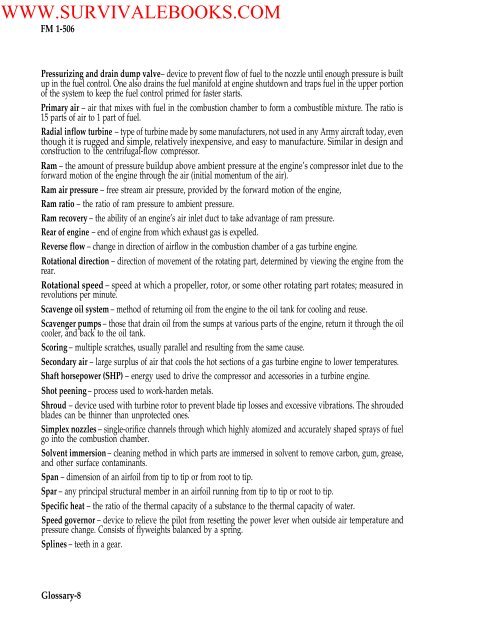FM 1-506 Fundamentals of Aircraft Power Plants ... - Survival Books
FM 1-506 Fundamentals of Aircraft Power Plants ... - Survival Books
FM 1-506 Fundamentals of Aircraft Power Plants ... - Survival Books
You also want an ePaper? Increase the reach of your titles
YUMPU automatically turns print PDFs into web optimized ePapers that Google loves.
WWW.SURVIVALEBOOKS.COM<strong>FM</strong> 1-<strong>506</strong>Pressurizing and drain dump valve– device to prevent flow <strong>of</strong> fuel to the nozzle until enough pressure is builtup in the fuel control. One also drains the fuel manifold at engine shutdown and traps fuel in the upper portion<strong>of</strong> the system to keep the fuel control primed for faster starts.Primary air – air that mixes with fuel in the combustion chamber to form a combustible mixture. The ratio is15 parts <strong>of</strong> air to 1 part <strong>of</strong> fuel.Radial inflow turbine – type <strong>of</strong> turbine made by some manufacturers, not used in any Army aircraft today, eventhough it is rugged and simple, relatively inexpensive, and easy to manufacture. Similar in design andconstruction to the centrifugal-flow compressor.Ram – the amount <strong>of</strong> pressure buildup above ambient pressure at the engine’s compressor inlet due to theforward motion <strong>of</strong> the engine through the air (initial momentum <strong>of</strong> the air).Ram air pressure – free stream air pressure, provided by the forward motion <strong>of</strong> the engine,Ram ratio – the ratio <strong>of</strong> ram pressure to ambient pressure.Ram recovery – the ability <strong>of</strong> an engine’s air inlet duct to take advantage <strong>of</strong> ram pressure.Rear <strong>of</strong> engine – end <strong>of</strong> engine from which exhaust gas is expelled.Reverse flow – change in direction <strong>of</strong> airflow in the combustion chamber <strong>of</strong> a gas turbine engine.Rotational direction – direction <strong>of</strong> movement <strong>of</strong> the rotating part, determined by viewing the engine from therear.Rotational speed – speed at which a propeller, rotor, or some other rotating part rotates; measured inrevolutions per minute.Scavenge oil system – method <strong>of</strong> returning oil from the engine to the oil tank for cooling and reuse.Scavenger pumps – those that drain oil from the sumps at various parts <strong>of</strong> the engine, return it through the oilcooler, and back to the oil tank.Scoring – multiple scratches, usually parallel and resulting from the same cause.Secondary air – large surplus <strong>of</strong> air that cools the hot sections <strong>of</strong> a gas turbine engine to lower temperatures.Shaft horsepower (SHP) – energy used to drive the compressor and accessories in a turbine engine.Shot peening – process used to work-harden metals.Shroud – device used with turbine rotor to prevent blade tip losses and excessive vibrations. The shroudedblades can be thinner than unprotected ones.Simplex nozzles – single-orifice channels through which highly atomized and accurately shaped sprays <strong>of</strong> fuelgo into the combustion chamber.Solvent immersion – cleaning method in which parts are immersed in solvent to remove carbon, gum, grease,and other surface contaminants.Span – dimension <strong>of</strong> an airfoil from tip to tip or from root to tip.Spar – any principal structural member in an airfoil running from tip to tip or root to tip.Specific heat – the ratio <strong>of</strong> the thermal capacity <strong>of</strong> a substance to the thermal capacity <strong>of</strong> water.Speed governor – device to relieve the pilot from resetting the power lever when outside air temperature andpressure change. Consists <strong>of</strong> flyweights balanced by a spring.Splines – teeth in a gear.Glossary-8
















